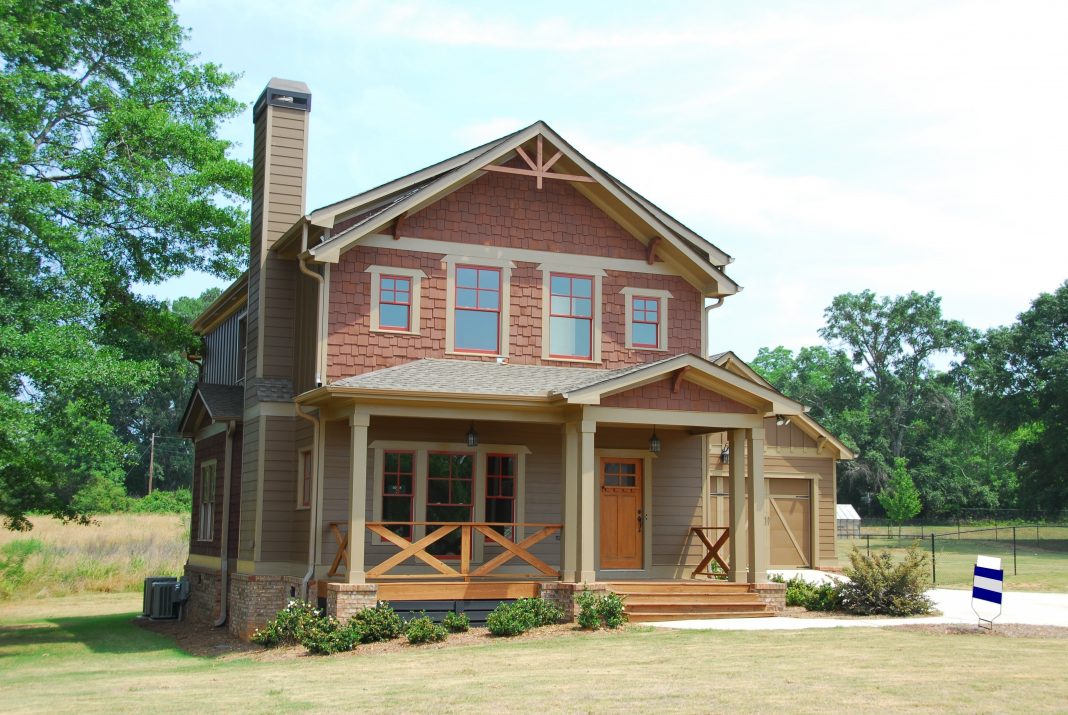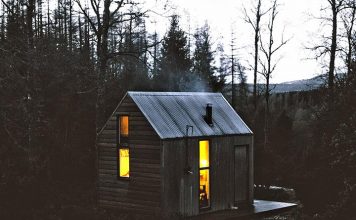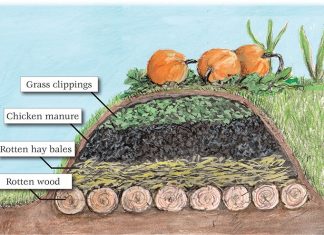| Website Exclusive • August, 2004 |
Any good carpenter can build a staircase. What we’re talking about here is taking that staircase to the next level: beyond just a means to get from one floor in a building to another.
|
(There are many books available that already do an admirable job of explaining the techno-stuff and mechanics of designing and building stairs. Some suggestions are at the end of this article.)
What we are going to discuss here are the aesthetics and ergonomics of stair design, and the value of a staircase that goes way beyond the function of providing a means to get from one floor to the next. This is the information that’s left out of the technical books, and it is exactly this information that makes the difference between a technically-correct, code-legal staircase and one that’s a work of art, inviting, and a pleasure to use.
An interior staircase can be the focal point of a room; an exterior stair can light up the face of a whole building. But more often than not, stairs appear to have been designed to be quick, cheap and easy to build; to take up the least amount of space possible, or to get them out of sight or out of the way. Many times they appear to have been designed as an afterthought: “Now that we’ve got a second floor, where are we gonna put the stairs?”
|
A staircase can be so visually inviting that it beckons one to try it outto see where it leads. A properly done staircase is comfortable to walk and visually interesting. A staircase can be designed to have a landing that affords a unique view of a room below or out of a special window. But too often, staircases are basically boring, many are uncomfortable or tiring to walk, some are even downright dangerous. Many perfectly legal and structurally correct staircases are intimidating by being too steep, dark, or narrow. Maybe even all of the above.
So what are the ingredients of the perfect staircase design? The basic components are safety, comfort, eye-appeal, and visual and functional integration into the design of the room or building. Often, these elements are simple to put into practice. Sometimes they take some careful thought and even a bit of creativity.
|
There are only a few fundamental rules that when adhered to will produce a safe, easy-to-walk, comfortable staircase. The visual aspect is admittedly a little more subjective, but there are some basic guidelines that apply here, as well.
The examples we’ll use in this article are all fairly simple and inexpensive structures. We know what a drag it is to read an article on “how to design a staircase” and find each of the examples probably cost more than our whole house!
Getting Started
In new construction, it’s usually fairly easy to design stairs that meet all our requirements. Creating a good design when a second floor is added to an existing building, or an additional staircase is planned for an existing upper floor can present a bigger challenge.
|
Even in new construction, I am continually amazed when an otherwise good designer or architect does a nice-looking house but then includes a long, narrow, single-run, intimidating staircase. I live in Hawaii and this issue is common here where many of our homes have the main living area on the second floor.
A tiny bit of techno-stuff
OK, I know techno-stuff makes for some pretty unexciting reading, but I’m afraid that we have to start with one technical rule as the basis on which to design all staircases. Enter the fundamental rule of designing any staircase, the “Rule of 25.” It goes like this: a staircase will be safe and easily walkable if the height of two risers plus the width of one tread equals 25. Sounds too easy, doesn’t it? It really works! (And it is covered in most of the technical books.)
First, let’s make sure we are all talking the same language here. Please take a look at Dwg. 1 for some stair-speak definitions. Rise is the height from the floor to the top of the first tread, or the height from the top of any one tread to the top of the next one. Run is the width of each tread, or the distance from the face of one riser to the face of the next one.
|
Unit rise describes this dimension for only one step of the staircase, and unit run is the dimension for only one tread.
Total rise is the height from the floor-surface to the next floor-surface serviced by the staircase. Total run is the length of the whole staircase, or the combined lengths of all the treads.
The minimum unit rise for a normal staircase is usually 4″, and the maximum, except for service-stairs (stairs that aren’t used often) is 7″. Service stairs can go as high as 8″, but this is considered a really steep staircase. The most comfortable range for the average staircase and the average person is between 6 and 6-½ inches.
You will find that most staircases, especially interior ones, are steeper than they should optimally be. The reasons for this trend are several. A common one is that the designer of the house was working with a limited budget and that always boils down to keeping everything as small as possible to conserve materials.
|
Another reason, and one way too common, is that the designer never really considered the importance of good stair design. Perhaps s/he simply felt (as many do) that if the structural requirements are met, that’s all it takes. After all, it’s just a staircase!
OK, enough philosophy! The logic behind the “Rule of 25″ is simple: For a staircase to be comfortable to walk at a natural pace, the wider the tread gets, the lower the riser must be. Conversely, the higher the riser, the narrower the tread. For example, to determine the best width for the treads of a staircase that will have a 7″ unit rise, use the Rule of 25: 7+7=14, then 25-14=11. A staircase with a 7″ unit rise will need an 11″ unit run (or 11″ wide treads) to be comfortable and safe to walk by the average person.
Another example: Let’s say you would like to maintain 12″ treads (unit run) on your entry stairs. 25-12=13. 13 divided by 2 equals 6-1/2. The unit rise, or the height of each step, will then be 6-1/2”.
|
This amazing rule is not just somebody’s opinion or another “old wive’s tale,” either. Try walking various staircases and taking note of ones that are comfortable and just seem to naturally fit your feet and gait. Then measure the rise and run. Now try measuring some that seem awkward. You will find that the Rule of 25 applies every time.
Another detail, and this is one that’s covered in every building code (for good reason), is that each unit rise and each unit run must be the same. Different building departments will specify different limits here, but they usually specify 1/4″ or 3/8″ maximum variation. The unit rise limitation is essential.
Personally, I keep mine within 1/8″. It’s surprising that such a little variation in step-height can make such a difference in walkability, but it really does. When you go up or down stairs, your body automatically adjusts your gait for the height of the steps. If you get to one that isn’t the same as the rest, you will almost surely trip. Going up, you’ll catch a toe on a high step or you’ll lose your gait, or rhythm on a low one. Going down uneven staircases has caused many people serious falls.
One of the worst ones I’ve ever experienced was a long, straight staircase of about 7″ risers. The bottom riser was only about 5″. Even though I had used this stair on several occasions, it almost always caused a stumble at the bottom.
OK, that takes care of the technical stuff. From here we go beyond the technical and venture into the human element: the aesthetic and psychological aspects of stair design.
The Planning Stage
In the design phase of a new building, consider the staircase as an architectural feature of the building. Properly done, an attractive staircase can transform an otherwise ordinary-looking building into a showpiece! Exterior, or entry stairs should be inviting. From the first moment they come into view to a person approaching the building, the stairs should welcome the visitor. From a design point of view, this means that the stairs should not only be gradual, and easy to climb, but they must present a gracious invitation.
|
The easiest way to offer graciousness in most areas of construction design is to make the particular element a little more generous than is absolutely necessary. Sounds simple, but it works. If an entry stair needs to be four feet wide to satisfy code requirements, make it six feet wide. Or wider.
Another little detail that almost always enhances any staircase is to make the bottom step or two a little wider than the following ones. Photo 1 illustrates both these points. First, this simple staircase, which could have been three or four feet wide and still satisfy legal and safety requirements, is actually a little over six feet wide. Look at the picture and imagine it being only three or four feet wide. See the difference? Well, as it turns out, it would have presented an even more inviting face at eight feet wide.
Notice that the bottom wooden step wraps around the posts, and the concrete step is a bit wider than the wooden one. The staircase seems to “flow” out onto the ground like the open arms of a waiting and welcome embrace. Again, it would have looked even better had the concrete step been a full foot wider than the first wooden step.
Adding a feeling of graciousness to a staircase by making the first few steps wider than the following ones works well in most cases, but care must be taken here to avoid making a staircase appear to be “narrowing,” which is distinctly intimidating. The object is to open up the first few steps of an already inviting staircase.

When the length limitation of a staircase (the total run) seems to dictate a too-narrow tread-width, consider cutting the top step into the upper floor, as in Photo 2. In this case, the stairs were not to protrude out onto the lawn any farther than necessary, but the design still called for 12″ treads to achieve the desired overall appearance and walkability. Here, the top stair was notched into the deck, creating both a visual-interest point from the deck and maintaining the desired tread width without having the staircase extend farther from the building than necessary. There are limitations to this treatment: if the notch into the upper floor is deeper than one step-width, provisions have to be made to avoid having someone step into the “notch” when approaching from the side. Extending a handrail onto the upper floor area would serve this purpose.

A different treatment of front-porch steps (Photo 3), these go all the way across the width of the porch. The goal was to avoid the cramped feeling a narrow staircase would have given this small porch. For sure, artistic expression, interpretation and perception varies among individuals, but the basics remain the same: cramped, narrow and/or steep staircases are not inviting to most humans.
Interior Stairs
These same principles of widening the base of a staircase apply to interior stairs. There are several ways this can be accomplished, too. One of the most effective, especially if the staircase runs down alongside a wall is to have it turn ninety degrees into the room by way of a landing that is a foot or two wider than the width of the staircase itself. Then the first one or two steps up to that landing are the full width (or wider) than the landing. (See Dwg. 2.)
The ninety-degree turn at the bottom of a staircase that runs parallel to a wall has another benefit, too. A staircase is always more inviting if it opens into the space from which its traffic arrives. In other words, the bottom stairs should face into the room serviced by the staircase.
Go that Extra Mile
Even if it feels necessary to keep everything in a building to code minimums to cut down costs (Guess why tract houses all look the same?), the small extra cost of making a staircase a little wider than required by the building code is soon forgotten, but the convenience, feel and ambiance it provides is permanent.
|
It’s best to avoid narrow stairs in any place where they will be used often. Consider the potential (and probable) uses of a staircase, too. Will furniture have to be carried up and down? Appliances? Will there be a likelihood of opposing traffic?
The same thing applies to steep staircases. Most staircases are steeper than they need be, and most are that way just because the designer either didn’t want to put in the extra effort required to make a more comfortable staircase fit in the same space, or the builder (or owner) wanted to “keep things simple and cheap.” Often, it does take some extra time and effort to plan the perfect staircase. And it almost always involves a little extra labor and cost to build it. But in my experience of designing and building (and selling) custom homes, it has always been worthwhile. I believe that my staircases have been instrumental in selling my homes, and it’s not that someone would exclaim, “Wow! That staircase! I’ve got to have this place!” What happens is that people are drawn to overall ambiance of the place, and even though they don’t realize it, the stairs have a lot to do with it.
Long Staircases, Interior or Exterior
The width-to-length ratio of the entire staircase is one of the most important details to take into consideration when designing any stairs. In most circumstances, a long, narrow staircase looks intimidatingfrom the top or the bottom. If a lot of stairs are needed because of a big elevation change, break up the staircase with landings. Keep each run of stairs fairly short, with about eight steps being a maximum if at all possible.
An example of this technique is shown in Photo 4. This staircase approaches the house at an angle, goes up to a generous landing, from there only another few steps to a second landing, and then up to the main floor of the house. The first landing (Photo 5) is where the staircase straightens out to approach the building at right angles.
|
Legally, this staircase could have been three feet wide. Building it 54″ wide softened the visual impact of what is really quite a long climb. In all, there are seventeen steps, an intimidating sight for a lot of folks who aren’t especially happy about or capable of climbing a lot of stairs. Breaking up that run into several shorter ones not only offers some resting places, but it makes for a much more visually appealing staircase. Photo 6 shows the view of the stairs from the top.
Integrating the support structures of a staircase into the visual design is pretty easy on exterior stairs. In the staircase in Photo 7, the center support carries the center of the run, the center railing post, and offers some visual interest as well. The diagonal brace carries the load of the run down to the foundation of the building. It is tied into a stud right above the floor plate of the wall. Photo 8 shows the staircase from a different angle.
Different Styles
Stairs can be open, enclosed, all-wood, carpeted, or combinations of these. An example of a combination approach is pictured in Photo 9. The bottom of this staircase is a three-steps-up landing (not visible in the photo; see Dwg. 2), a foot wider than the staircase. From there, the open, wooden run goes to a second landing, from where the remainder of the steps are enclosed and carpeted to match the second floor. The staircase affords several interesting views of the room below (Photo 10.)
Much of the visual interest in this particular staircase comes from the assembly techniques used in the open stairs (Photo 11). The materials used in building this run were carefully selected from the rough-framing lumber used in building the house. As the construction progressed, these nice clear pieces were set aside out of the weather. The wood is all nearly knot-free fir with the exception of the end-caps on the treads, which are dark cedar. The staircase was finished with several coats of high-quality spar varnish. A staircase like this is admittedly labor-intensive, and a much simpler way would have been to enclose and carpet it all the way. But this staircase was designed not only to be a focal point of the room, but its openness visually subtracted less space from the fairly small living room.
|
An example of a fully-enclosed, carpeted stairway, and the visual interest it created in a small building, is shown in Photo 12.
There are three landings in this staircase, making the whole unit take up very little actual floor space, yet the riser heights are a comfortable 6-1/2″. Every cubic foot of space under the staircase has been utilized, too. The view from the top landing (Photo 13) shows a bit of the scene below. This relatively small (1400 sq. ft) home has expansive views like this throughout, giving the feeling of a much larger, more open space. Stairways are the perfect medium to make these views possible.
Notice the stair lights in some of these staircases, too. They are inexpensive, and make it possible to illuminate the stairs with very low-wattage lamps. A light is placed near the edge of each landing and in the middle of a run longer than three or four steps.
A staircase can also be a simple U-shape, with half the run going in each direction (See Dwg 3.) In this home, the two small windows at the landing afford an interesting view of the garden outside. The landing also looks down into the kitchen and dining room, making for a fun conversation spot. The partition wall between the staircase and the kitchen is seven feet high and flush with the tops of the upper kitchen cabinets, making it a little higher than handrail height at the landing. The top of this wall has a finished mahogany cap, is a full 16″ wide, and it makes a fine spot to sit and chat with the cook. It’s also a great place for some nice plants. The space under the landing is used for storage, and is accessible through a door underneath the upper stair-run.
Often, an interior staircase can be constructed outside of the actual building. This technique works in new construction, but is especially well-suited to an upstairs add-on, as no existing floor space is required. (See Dwgs. 4a, 4b) The supporting structure for the staircase can be cantilevered from beneath the building, supported from the ground, or it can be hung from the existing wall structure.
|
An interesting point to keep in mind for second-floor spaces like apartments or offices is that an exterior access to these spaces is not only a convenience, but it gives whoever lives in or uses that space a feeling of autonomy and independence. A staircase like this one could have both an exterior and interior access from the lower level. Having to go through someone else’s space to get to your own is often uncomfortable. It’s much more pleasant to have your own entry. We’re back to graciousness here.
Handrails
Another essential ingredient of any staircase is the handrail. The dimensional limits of handrails are spelled out in the technical stair-design books, and are also strictly enforced by the building codes, but again, there are other considerations that go beyond the requirements. These include not only aesthetics, but thoughtful little details that can make the handrail more than just something to hold onto.
Handrails should be designed to compliment the staircase itself and any adjacent trim. When designing a handrail, picture yourself holding onto it and sliding your hand along its entire length. The no-splinters part is obvious, but not so obvious is the ability to run your hand along the railing without hitting the mounting hardware or brackets, or encountering tight spots not quite big enough to pass a large hand comfortably and safely. Handrails must also accommodate small hands, so a 2×4 laid flat won’t make it. The building codes specify handrail size and height limits, so check the codes in your area to make sure. Handrails should also start and end so that they fall to hand naturally when approaching and leaving the staircase.
Another very important and often overlooked aspect of designing and building handrails is that they need to be rigid and well braced. A handrail, especially one that is more than a few feet from the ground, can feel real scary if it moves even slightly when leaned upon. Properly done, a railing or handrail shouldn’t yield at all under anything that could be considered normal pressure. And for sure it better not fail if someone falls against it! (Like they always do in the movies!)
|
OK, the rest is up to you! I’ve given you the basics of gracious stair design and some examples of staircases I’ve built, none of which were particularly expensive to create. (I get really irritated at some of the home and building publications that run these articles on building things that only the rich and famous can afford! Like a staircase that would cost more than my entire house.)
I suggest that if you’re about to design a staircase, pay close attention to every staircase you come across and really feel it. Ask yourself how it could have been done better. Become a constructive staircase critic and you will become a better staircase designer. It’s not that all difficult; it just takes some creativity and vision!
Short Bibliography:
Rob Thallon’s Graphic Guide to Frame Construction has a terrific section on the technical-design aspects of every kind of stairs imaginable. (ISBN: 1-56158-040-6, The Taunton Press.) I’ve been building houses for more years than I can remember, and this book is still my most valuable reference. You can build a frame house from the ground up with just this book as your guide. The text is clear, it is supported by excellent illustrations throughout, and the index is super.
The GrandDaddy of all residential design books is A Pattern Language (ISBN: 0-19-501919-9, Oxford University Press.) This is definitely NOT a techno publication and I recommend you find it in your library because it’s real pricey. It lists for $65 and is available from Amazon at about $44.
Skip Thomsen is a (sort-of-retired) designer and builder of one-of-a-kind homes that are individually crafted to be at ease with their immediate environment. He is the author of several homesteading-related books and has submitted numerous articles to BHM. He lives in rural Hawaii with his Bride and three cats. All Photos, drawings and stairs are by the author.



























